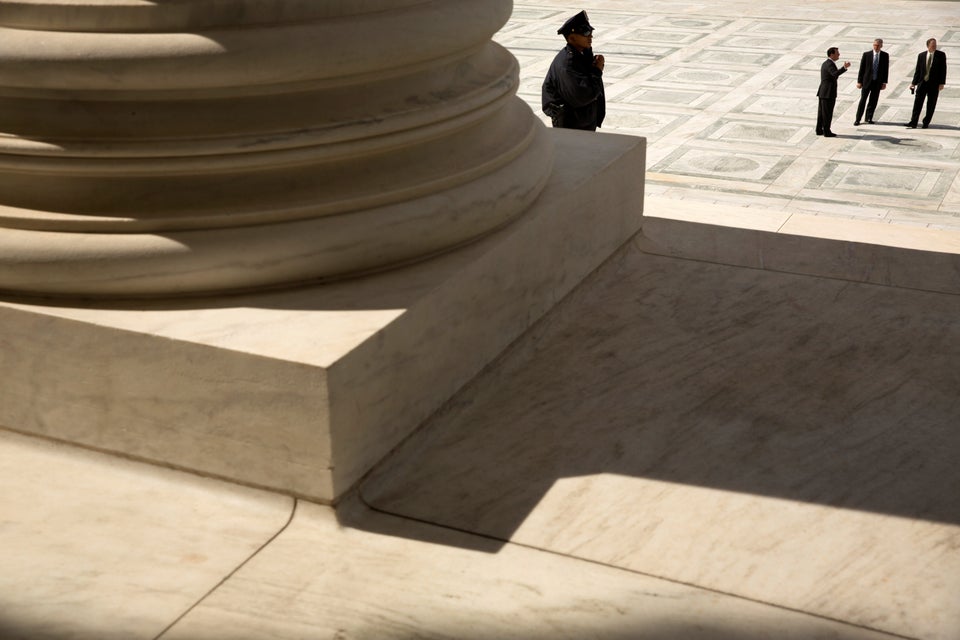WASHINGTON ― Supreme Court justices appeared divided on Wednesday over whether an Ohio process for removing people from the voter rolls was a violation of federal law.
In Ohio, if someone doesn’t vote for two years, they receive a notice in the mail confirming their address. If they fail to respond to the notice, and fail to vote for an additional four years, they get removed from the voter rolls.
The plaintiffs in the case allege the process violates a provision in federal law that bars states from removing people from the rolls simply because they don’t vote. States are required under federal law however, to make a reasonable effort to clean their voter rolls.
Eric Murphy, the Ohio solicitor general, faced sharp questions on Wednesday from Justices Elena Kagan and Sonia Sotomayor over the process.
Sotomayor pressed Murphy on the consequences the Ohio process would have, particularly on poor and minority populations. She questioned whether failing to respond to a notice and not voting from the state was really enough evidence to indicate a voter had moved and might be ineligible. She noted that in Ohio there are large groups of minorities and homeless people who face obstacles to voting like long lines at the polls. She asked Murphy how the state could begin a “process of disenfranchisement” without reasonable evidence someone had moved.
But Murphy said the state didn’t need to have precise evidence because it only was required to make a “reasonable effort” under federal law.
Ohio’s process was clearly permissible under two federal laws, the 1993 National Voter Registration Act (NVRA) and the 2002 Help America Vote Act (HAVA), Murphy said. Both laws make it clear someone can’t be removed from the rolls for not voting, but do allow states to take a history of not voting in federal elections into account when they remove people.
The central question in the Ohio case is whether sending the initial mailing to people who don’t vote and then removing them if they fail to respond and then don’t vote for four more years amounts to removing people because they don’t vote.
Justice Stephen Breyer seemed sympathetic to the state’s need to maintain accurate rolls, pressing Paul Smith, the lawyer for the plaintiffs challenging the Ohio law, on what processes states could use to reasonably identify people who had moved. He asked Smith how the state of Rhode Island, for example, could know if one of its eligible voters had moved to Tasmania and died there.
Smith responded by noting the federal government keeps records of people who died and that when people move they update their address with the state motor vehicle agency and the post office. The state could use that kind of evidence to determine whether someone had moved.
Smith also focused on the fact that in Ohio, the purging process is initiated when the state doesn’t get any response from a voter, not if mail cannot be returned. A process in which a state began a purging process based on returned undeliverable mail in addition to not voting for a period of three our four years would be more acceptable, he conceded, because the undeliverable mailing would provide the state with some kind of concrete evidence someone may have moved. Under Ohio’s current process, Smith said, 70 percent don’t respond to the confirmation mailing.
A handful of states use processes similar to the one used in Ohio, but civil rights groups say the state is particularly aggressive in purging people from the rolls. A ruling from the high court backing Ohio could embolden states to adopt more aggressive voting procedures.
Smith questioned why Ohio needed such an aggressive purging tactic at all, saying only 3 percent of Americans move each year and many take steps to update their address.
Justice Samuel Alito and Chief Justice John Roberts seemed more skeptical of the challenge to the Ohio process. Alito at one point asked Smith whether someone not voting for 20 years would be enough of indication someone had moved, indicating to him it was. Smith noted that there were plenty of people in the United States who for a variety of reasons might not vote over 20 years. Larry Harmon, the plaintiff in the case, was purged after not voting for six years but had lived at the same address for about 16 years.
Justice Anthony Kennedy also seemed sympathetic to Ohio’s position, while Justice Ruth Bader Ginsburg spoke little and offered no clear indication of her thinking.
Justices Neil Gorsuch and Clarence Thomas did not speak during Wednesday’s oral argument.
The case is also notable because the Justice Department switched its position this summer after the Supreme Court agreed to hear it. The Department previously supported the challenge to the Ohio law in a brief at the U.S. Court of Appeals for the Sixth Circuit, but the Trump administration switched positions to back the state.
Sotomayor pressed U.S. Solicitor General Noel Francisco on the change during oral arguments Wednesday, saying that solicitors general from Democratic and Republican presidents alike had argued positions at odds with the one the Justice Department was now taking.
In its brief to the court, the Solicitor General’s office said it switched positions after the change in administrations and reevaluated the statute. Francisco told Sotomayor the department had always believed Ohio’s system was compatible with the NVRA.

